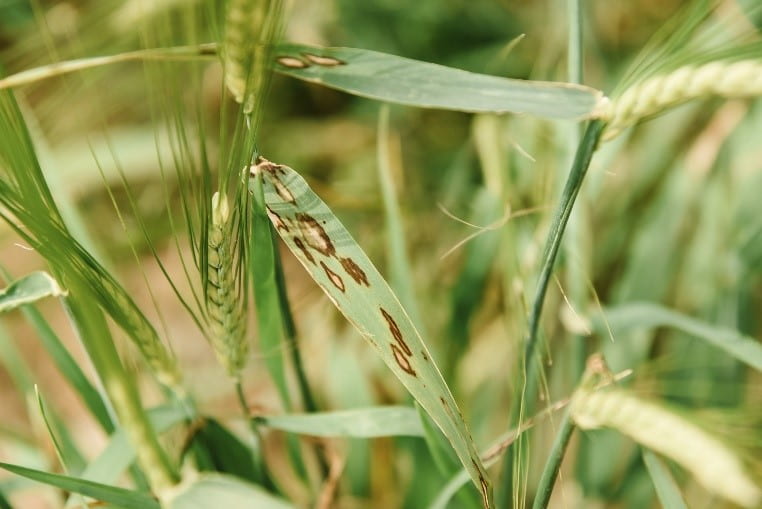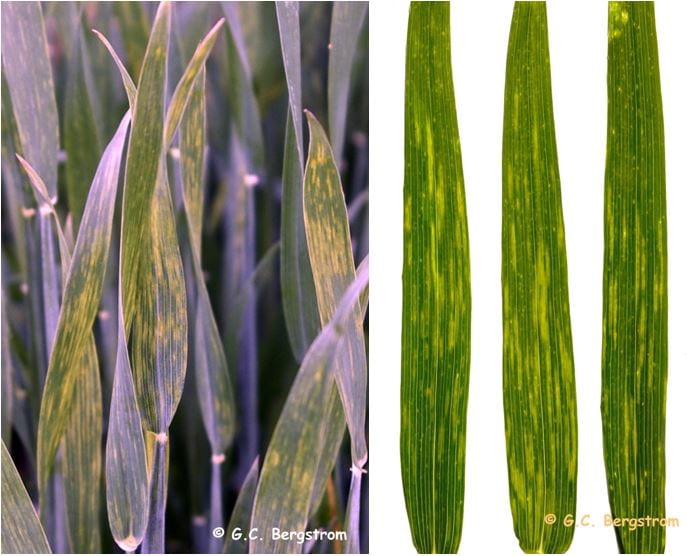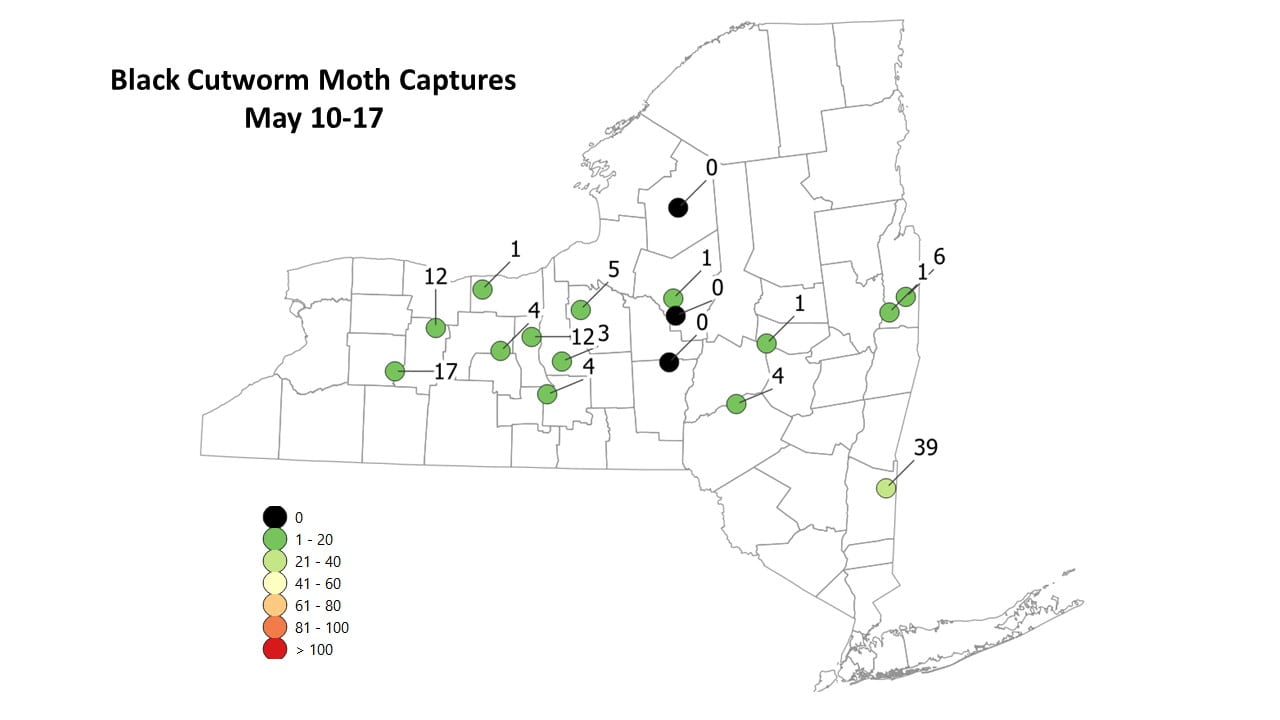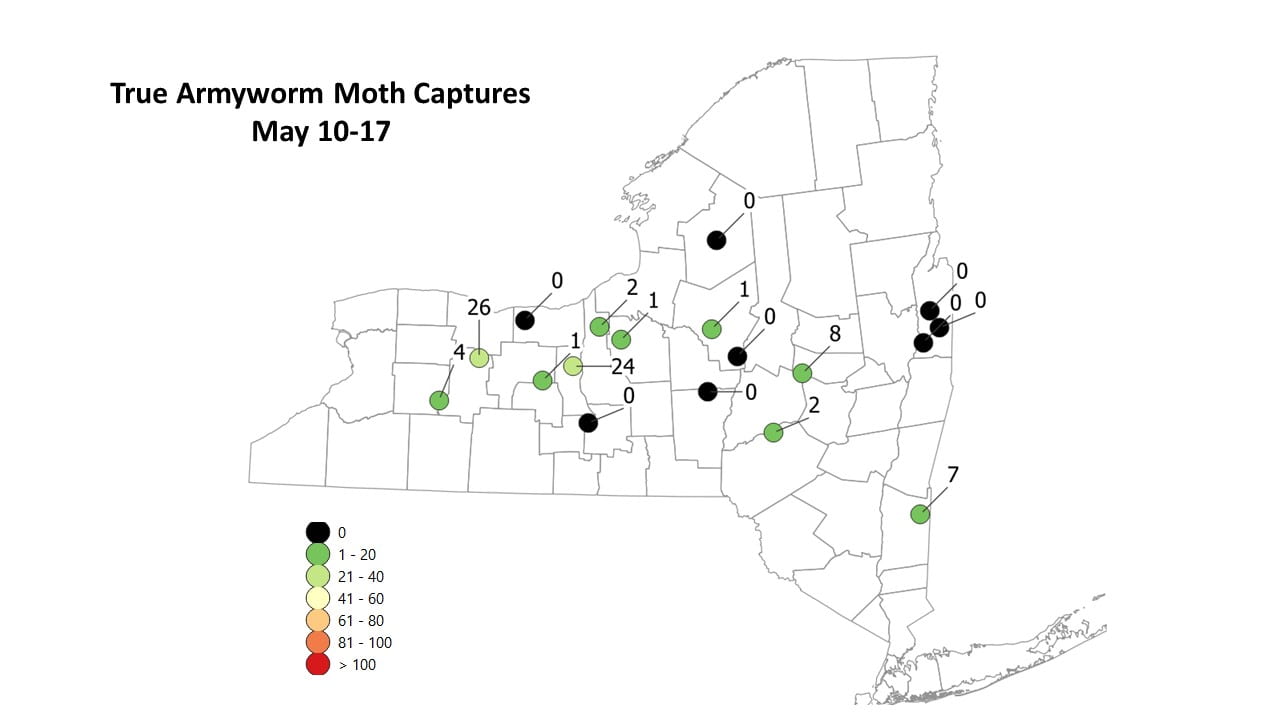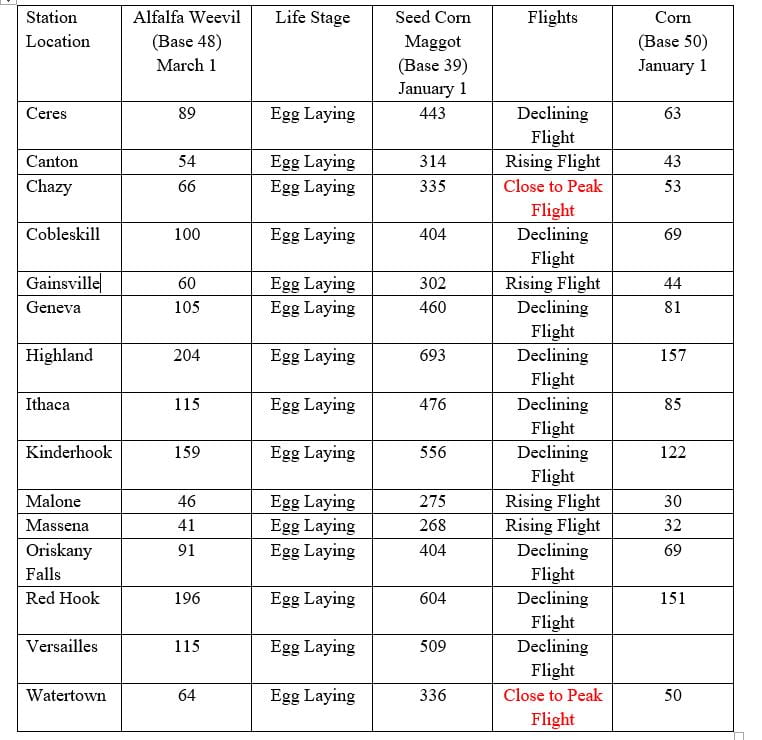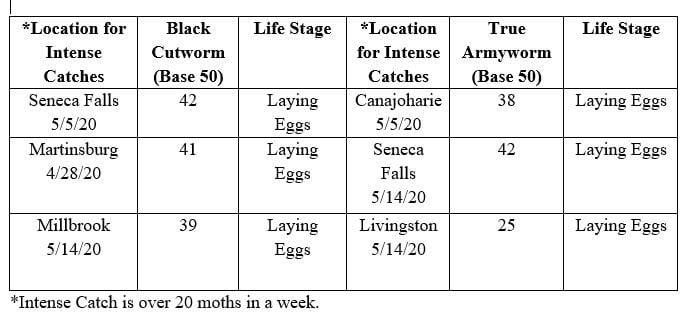May 18, 2020
Volume 19, Number 2
Contents
View from the Field
Many clover root curculio adults were found in alfalfa in Dutchess County. This is a very damaging insect pest that has no management practices, except rotation. The larvae feed on the roots of the plant allowing diseases to enter. While it is not a problem in a first-year field, it can build up from year to year. This is one of the reasons alfalfa stands decline in New York.
Clover Root Curculio (photo by Ken Wise-NYS IPM)
The hot spot of the week for black cutworm moth captures was in Dutchess County with 39 moths caught last week. The hot spots for true armyworm last week were Livingston County with 26 moths and Seneca County with 24 moths caught.
There are a few reports of scald on barley this week. According to Jaime Cummings (NYS IPM), Scald is a fungal leaf spot that is easily identified on winter malting barley by its distinctive lesions that can be found on any above-ground plant tissue. The fungal pathogen can over-winter on residues or can be seed-transmitted. On susceptible cultivars and under favorable environmental conditions, scald can spread quickly throughout the canopy and field, resulting in significant yield loss. Pay attention to scald resistance ratings when selecting malting barley cultivars to plant, as they vary drastically in susceptibility. Susceptible cultivars will benefit from a triazole fungicide application at flag leaf, or even earlier to protect yields.
Wheat spindle streak mosaic in spring: A reminder to plant a resistant wheat variety in fall
Gary C. Bergstrom: Plant Pathology and Plant-Microbe Biology Section
Cornell University
The Disease
Wheat spindle streak mosaic (WSSM), caused by wheat spindle streak mosaic virus (WSSMV), is a disease that attracts little attention today because most of our widely grown, winter wheat varieties have significant levels of resistance to it. Yet WSSMV persists in New York soils in its protozoan vector ready to infect the roots of susceptible winter wheat varieties soon after planting. Swimming spores (zoospores) of the vector move through films of water in the soil and thus root infection is favored by moist conditions in fall. Plants remain infected over the winter dormant period but do not develop typical leaf symptoms until spring following a number of weeks of cool weather which favors virus replication and virus movement from roots into shoots. Temperature, not moisture, is what drives symptom development in spring since plants were already infected in the fall. Only winter wheats, not spring wheats, are affected by WSSMV because of the time it takes to build up virus levels in the roots and then the shoots.
Symptoms
Symptoms of WSSM first appear in late April or early May and are characterized by long, light green, spindle-shaped streaks with dark centers (Fig. 1). As leaves age, these streaks can become necrotic and resemble lesions of Septoria tritici blotch but without dark fruiting bodies, i.e., pycnidia of Zymoseptoria, in evidence under a hand lens. Symptoms of WSSM fail to develop on new leaves that emerge when average daily temperatures exceed 60 F, though symptoms can reinitiate at later growth stages if persistent cool conditions occur during stem elongation, head emergence, and even grain-filling. Conditions have been ideal in April and May 2020 for development of WSSM. Symptom development is extremely sensitive to warm temperatures such that we have seen very little WSSM in years with high temperatures in early spring.
Management
What should a wheat producer do if she/he observes characteristic symptoms of WSSM this spring? There is no action that can be taken to mitigate WSSM in a growing crop – the yield damage, which can exceed 30% of the crop’s potential, has already occurred. However, diagnosis of the disease is a sure reminder that the variety they are currently growing is susceptible to WSSMV, and they need to choose a variety with at least moderate resistance for planting in the coming fall. This should elicit a conversation with your seed supplier about varieties resistant to WSSMV; some companies include that information on their website and in their seed catalogs but others do not. While the majority of available varieties express resistance to WSSMV, susceptible varieties appear in the seed market from time to time. Scores for WSSM also are included in winter wheat variety trial tabular results (https://blogs.cornell.edu/varietytrials/small-grains-wheat-oats-barley-triticale/small-grains-cultivar-trial-results/) from Cornell’s Small Grains Breeding Program in years when symptoms are observed.
If you find more pronounced mosaic and fewer distinct streak symptoms in a variety designated to be WSSMV-resistant, your wheat could be infected by another soilborne, protozoan-transmitted virus called soilborne wheat mosaic virus (SBWMV), which we have diagnosed occasionally in isolated fields in southern areas of the Finger Lakes Region. Resistance to SBWMV is independent from resistance to WSSMV, though it is also available from wheat seed suppliers in a choice of adapted varieties.
Figure 1. Characteristic symptoms of wheat spindle streak mosaic on wheat flag leaves at boot stage (A) and close-up of spindle streaks (B).
Black Cutworm Captures Map
True Armyworm Captures Map
Degree Day Model for Field Crops Insect Pests in New York
Alfalfa Weevil and Seed Corn Maggot
Black Cutworm and True Armyworm Degree Days
Clipboard Checklist
Keith Waldron, NYS IPM
General
*Walk fields to check tile flow, check and clear drainage outlets. Look for line breaks
*Note and record location of wet areas on field maps or aerial photo for future tiling considerations and crop decisions, check for areas of soil erosion
*Pre-plant weed evaluation, timing cultivation and/or pre-plant weed management
*Watch for early season weeds: winter annuals, chickweed, henbit, field penny cress, shepherd’s purse, giant and common ragweed, purple deadnettle, lambsquarters, redroot pigweed, velvetleaf, Pennsylvania smartweed, common sunflower, quackgrass, foxtail
Alfalfa:
*Evaluate established legume stands for winter damage (thinning stand, frost heave, Brown root rot), determine average alfalfa stand count adjust crop plans if necessary
*Monitor for alfalfa weevil, crown or foliar diseases
*Monitor new seedings for Pythium blight and Phytopthora Root Rot.
*Monitor for Alfalfa Snout Beetle (In Oswego, Jefferson, Cayuga, Wayne, Lewis, St. Lawrence, Clinton, Essex, and Franklin counties)
Small Grains:
*Monitor winter grain fields for over wintering survival (snow mold and other cold injury issues), weed issues (such, as winter annuals, corn chamomile and chickweed), growth stage, number of tillers, foliar diseases (powdery mildew, rusts)
*Check stands for soilborne virus diseases, Wheat spindle streak mosaic and Soilborne wheat mosaic, check for signs of powdery mildew or other maladies, cereal leaf beetle, weed escapes, goose damage
Corn:
*Prepare land and plant corn as conditions allow
*Pre-plant weed evaluation, timing cultivation and/or pre-plant weed management
*Emergence: assess stand, population count
Soybeans:
*Prepare land and plant soybeans as conditions allow
*Pre-plant weed evaluation, timing cultivation and/or pre-plant weed management
Pastures:
*Check and mend fences as needed.
*Check crop growth
*Monitor fields for invasive species, plants harmful to livestock
*Review/Plan rotation system
Equipment:
*Remove / clean soil and crop debris from equipment
*Arrange for custom weed control or check your own application or cultivator equipment for repairs.
*Carry appropriate / necessary NYS DEC and EPA required documents: (pesticide applicators license, pesticide labels, MSDS sheets, etc.) with application equipment
*Calibrate:
-planting equipment – maintain records on planting rate per field
-manure spreaders – maintain records on amount spread per field
-pesticide application equipment – Check nozzles, pumps, etc., recalibrate pesticide application equipment before use.
Storage:
* Check stored grain bins for temperature, moisture and signs of mold and insects. Aerate, core, transfer grain or treat as necessary
*Check forage allocation and anticipate feed program adjustments as forages from previous year are used up
*Plan where forages should be stored for optimum allocation next feeding season



